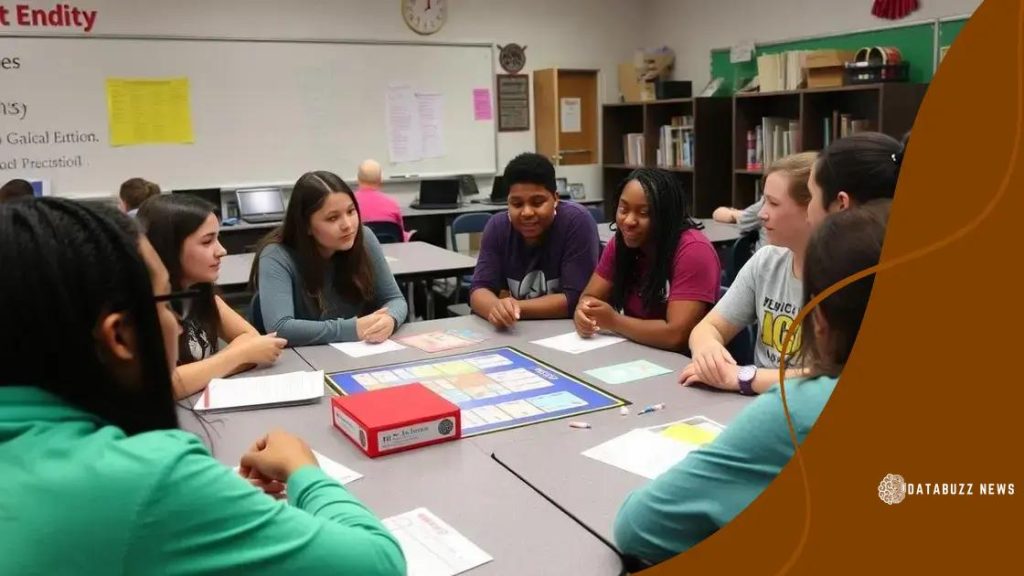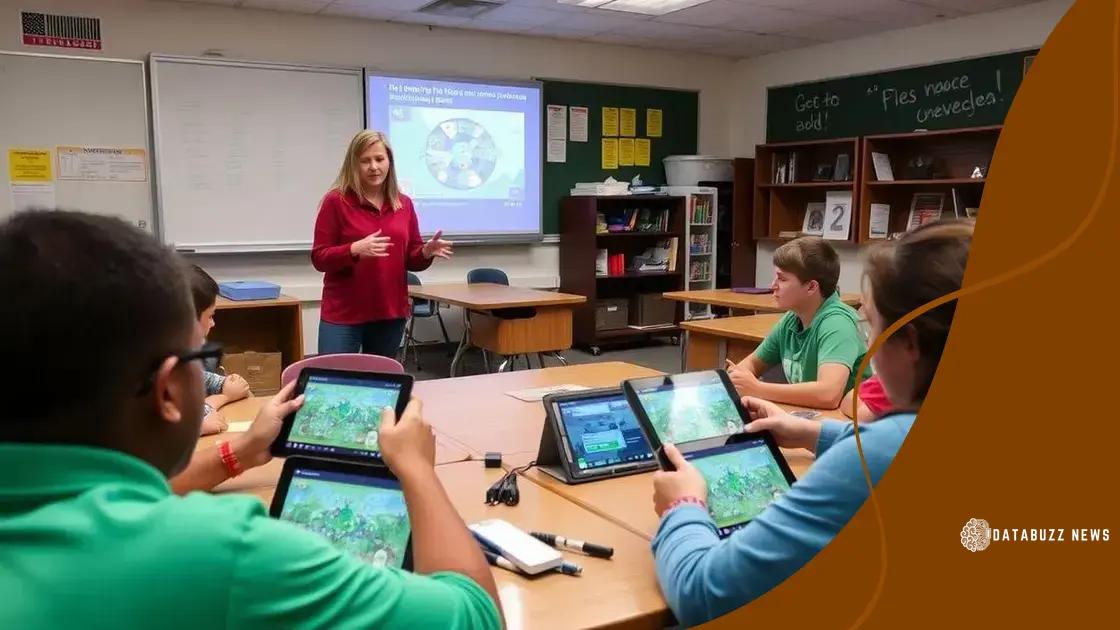Gamified financial literacy curricula in high school

Gamified financial literacy curricula enhance student engagement and retention by integrating game elements into learning, thereby making complex financial concepts more relatable and enjoyable.
Gamified financial literacy curricula in high school economics classes can transform the way students learn about money management. Imagine learning through games and interactive activities that not only engage but also empower young learners. Are you curious about how this works?
Importance of financial literacy in high school
Understanding the importance of financial literacy in high school is essential for students. In today’s world, young people face numerous financial decisions. Equipping them with the right skills early on makes a significant difference in their future.
The benefits of financial literacy
Teaching financial literacy can help students in various ways. They learn to manage money, save for the future, and make informed decisions. This knowledge leads to better financial habits.
- Developing budgeting skills
- Understanding credit and loans
- Making informed financial choices
- Preparing for future expenses
Additionally, financial literacy reduces the likelihood of debt. Students become aware of the consequences of poor financial decisions, which can lead to long-term financial struggles. By learning these concepts in high school, they can avoid common pitfalls.
Real-world applications
High school students who grasp financial literacy can apply their knowledge in real-life scenarios. For instance, they can create a budget for their allowances or even start saving for a car. These practical experiences reinforce their learning and foster confidence.
Moreover, understanding investments can open doors to wealth-building opportunities. Students proficient in financial concepts are more likely to explore stocks and savings accounts.
- Participating in savings programs
- Engaging in bank accounts management
- Exploring investment options
By emphasizing the importance of financial literacy, schools prepare students for a stable financial future. It’s not just about learning; it’s about applying knowledge to everyday life.
Benefits of gamification in education
Gamification in education has proven to be a game-changer. It makes learning more engaging and enjoyable for students. By incorporating elements like games, rewards, and challenges, educators can motivate students to participate actively.
Increased engagement
One of the primary benefits of gamification in education is increased engagement. Students often feel more connected to the material when it’s presented in a fun and interactive way. Activities that challenge them and spark their curiosity can lead to deeper learning.
- Encouraging teamwork through group challenges
- Boosting motivation with point systems
- Enhancing focus with game-like environments
This method also allows students to explore different topics through various formats. By using gamified lessons, teachers can cater to diverse learning styles. Visual learners may benefit from interactive simulations, while auditory learners enjoy discussions and storytelling.
Improved retention
Another key benefit is improved retention of information. When students are having fun, they’re more likely to remember what they learn. Gamified elements reinforce concepts and encourage practice, which solidifies knowledge longer.
Incorporating quizzes and interactive reviews can make a significant impact. Students find these activities entertaining, resulting in better knowledge retention than traditional methods. Additionally, application of skills in realistic scenarios helps them connect learning to real life.
- Utilizing game mechanics to repeat concepts
- Fostering problem-solving skills in safe environments
- Developing critical thinking through challenges
By embracing the benefits of gamification in education, teachers can create a more enriching environment. It leads to motivated learners who actively participate in their education, making learning a joyful experience.
How to implement gamified curricula

Implementing gamified curricula in high school can be a transformative experience for both students and teachers. The key is to integrate game elements into traditional teaching methods to enhance learning.
Define clear learning goals
The first step in implementing gamified curricula is to define clear learning goals. These objectives guide the design of the gamified elements. When students understand what they are expected to learn, they can engage more effectively. Setting specific, measurable goals ensures that both educational content and gameplay align.
- Identify essential topics and skills
- Develop assessment criteria for progress
- Ensure flexibility to accommodate different learning styles
Next, it’s important to choose the right game mechanics to include. This can involve using points, badges, and leaderboards to motivate students. By incorporating these elements, students are more likely to participate actively and stay motivated throughout the learning process.
Create engaging content
Another crucial aspect is to create engaging content that resonates with students. Utilizing real-world scenarios can make learning more relevant. For example, students can manage virtual budgets or invest in simulated stock markets. These activities not only enhance interest but also provide practical applications of theoretical knowledge.
Additionally, group work can foster collaboration and teamwork. By designing challenges that require group participation, students learn to communicate and solve problems together. This aspect of gamification nurtures vital social skills alongside academic learning.
- Design collaborative projects
- Incorporate storytelling elements into lessons
- Utilize technology, such as apps and interactive platforms
Finally, continually assess and adapt the gamified curricula based on student feedback and performance. This ongoing process ensures that the curriculum remains relevant and effective. By adjusting challenges and rewards, educators can maintain student interest and engagement over time.
Examples of successful gamified programs
Exploring successful gamified programs reveals the potential of this approach in education. Many schools have adopted gamification to enhance learning experiences and improve student engagement.
Classcraft
Classcraft is an excellent example of a gamified program. It transforms the classroom into a game where students earn points for positive behavior and academic achievements. They can customize characters and work collaboratively to unlock rewards. This system boosts motivation and encourages teamwork among students.
- Promotes positive behavior
- Enhances collaboration
- Encourages goal setting
Students find learning more enjoyable through challenges and interactive quests. As they progress, they deepen their understanding of the subjects they study.
Kahoot!
Another notable example is Kahoot!, an interactive quiz platform. Teachers create quizzes that students can answer in real-time using their devices. The competitive aspect of earning points and seeing their ranks motivates students to engage actively.
Using Kahoot! makes reviewing material fun and can be used in various subjects. The immediacy of feedback helps students identify areas needing improvement.
- Engages students through competition
- Provides instant feedback
- Utilizes multimedia questions
This blend of elements keeps students interested and helps reinforce learning through play.
Epic Win
Epic Win stands out for its focus on developing real-life skills through gamification. This program allows students to set personal goals. They earn rewards for completing tasks in school and at home, turning daily responsibilities into challenges.
This approach encourages students to take ownership of their learning and personal development. They enjoy the game-like experience while enhancing time management and organizational skills.
- Increases responsibility
- Encourages self-management
- Builds life skills through gamification
These examples of successful gamified programs demonstrate that integrating game mechanics into education can lead to more motivated and engaged learners. When students participate actively through gamification, they often achieve better academic results.
Challenges and solutions in gamified learning
Gamified learning offers many benefits, but it also presents challenges that educators must address. Understanding these challenges is crucial for successful implementation.
Resistance to change
One major challenge is resistance to change among teachers and students. Some educators may be hesitant to adopt new methods, fearing that gamification could disrupt traditional teaching practices. To help overcome this, professional development and training are essential. Workshops can familiarize teachers with gamification principles and how to integrate them effectively.
- Provide training sessions on gamification techniques
- Showcase successful case studies from other educators
- Encourage collaboration among teachers
Addressing these concerns helps create a supportive culture for implementing gamified learning.
Balancing engagement and learning
Another challenge is finding the right balance between engagement and actual learning. Students might be more focused on winning rewards than truly understanding the material. To mitigate this issue, educators should ensure that the fundamental learning objectives are clear and integrated into the game mechanics.
Game elements should reinforce educational goals rather than distract from them. This way, students remain engaged while still focusing on substance.
- Align game mechanics with learning outcomes
- Regularly assess student understanding
- Adjust activities to keep them focused on core concepts
By maintaining this balance, gamified learning can achieve its intended outcomes.
Technology challenges
Technology can also pose a challenge. Not every classroom has access to the necessary tools, such as computers or reliable internet connections. In such cases, educators might explore low-tech options that can still incorporate elements of gamification.
Using paper-based games or cooperative activities can still provide a gamified experience. Teachers could create challenges that require group participation, utilizing limited resources.
- Develop offline gamified activities
- Utilize classroom resources creatively
- Encourage peer interactions to lessen tech dependencies
By acknowledging and addressing these challenges, educators can successfully implement gamified learning strategies that enrich the educational experience.
FAQ – Frequently Asked Questions about Gamified Financial Literacy Curricula
What are the main benefits of gamified curricula?
Gamified curricula increase student engagement, improve retention of information, and make learning more enjoyable by incorporating game elements into traditional education.
How can teachers overcome resistance to gamification?
Teachers can provide training sessions, showcase successful case studies, and encourage collaboration among educators to help overcome resistance and ease the transition to gamified learning.
What technology challenges might arise when implementing gamification?
Challenges may include limited access to computers or internet connections; however, educators can explore low-tech options or develop offline gamified activities to ensure all students can participate.
How can the balance between engagement and learning be maintained in gamified learning?
Ensuring that game elements reinforce educational objectives rather than distract from them is key. Regular assessments of student understanding can also help maintain this balance.
